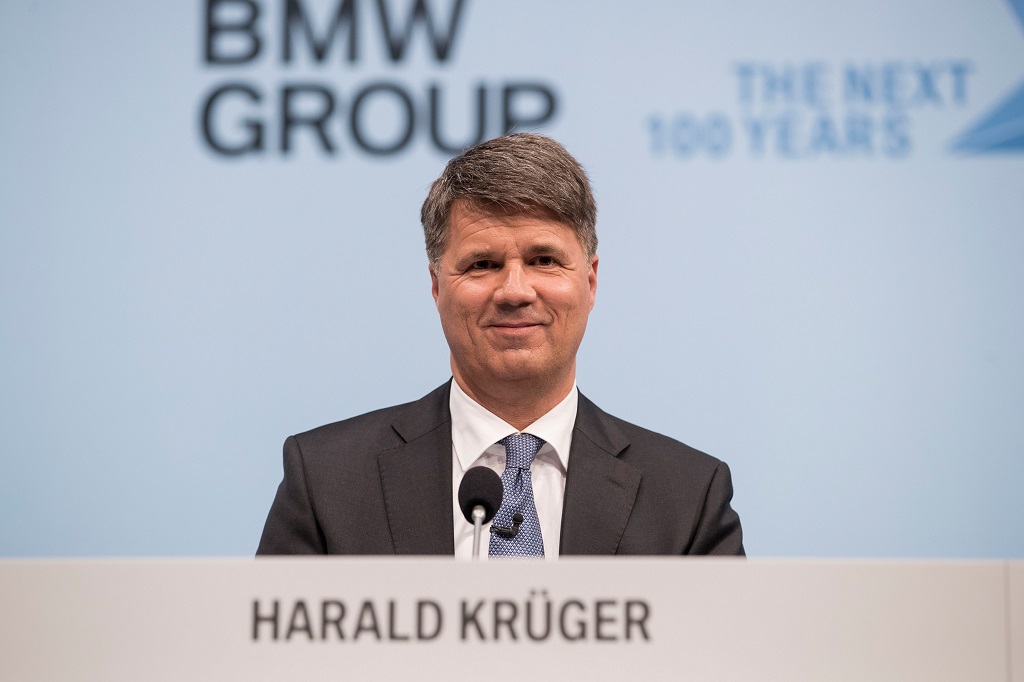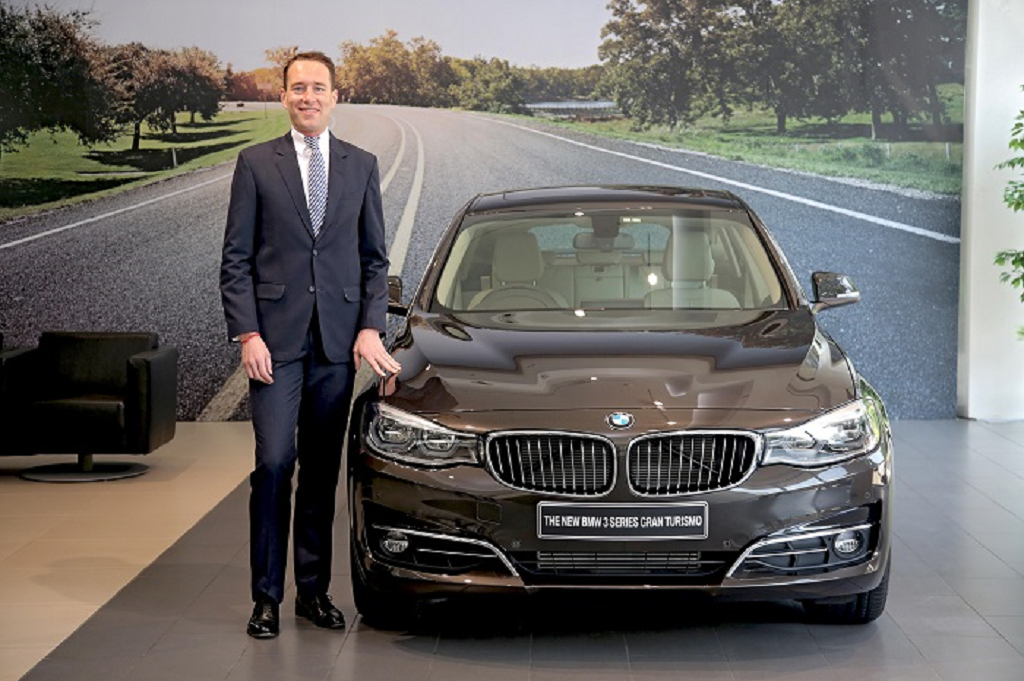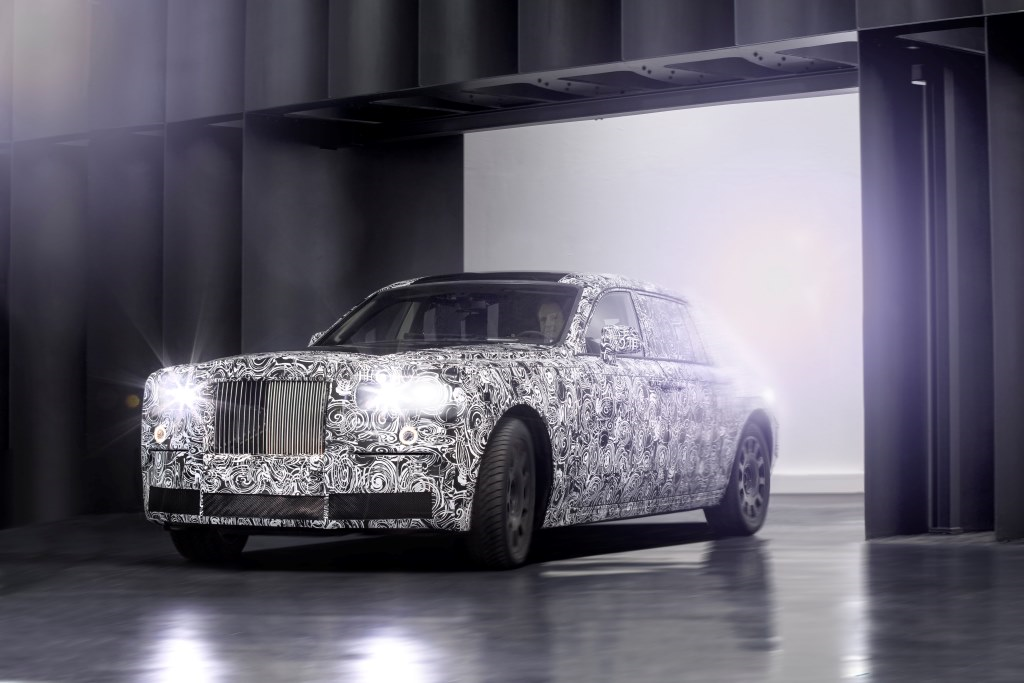Munich. After reporting best-ever revenues and earnings figures for the seventh year in succession, the BMW Group intends to continue its course of sustainable and profitable growth, while also expanding its role as innovation leader. The company’s core business will be strengthened by the targeted addition of new models and continued work on the strategic areas of electric mobility and automated driving.
“Once again, we are targeting record sales volume, revenues and earnings in 2017,” stated Harald Krüger, Chairman of the Board of Management of BMW AG in Munich on Tuesday. The BMW Group forecasts a slight increase in Automotive segment deliveries to customers in the current financial year, which would result in a corresponding growth in segment revenues. Group profit before taxes is also expected to improve slightly.
“Leadership in innovation and sustainable profitability are the keys to our success. That’s why, we are fully focused on meeting the wishes and needs of our customers, with the aim of igniting their enthusiasm for mobility day after day with appealing products and services,” Krüger commented.
With this in mind, the BMW Group will be rejuvenating its product portfolio significantly in the coming years. “We intend to launch more than 40 new and revised models of our three premium brands on the market during 2017 and 2018. The new product offensive began successfully with the launch of the new BMW 5 Series in February, further raising the bar in the business sedan segment,” continued Krüger.
Particular emphasis will be placed on the top end of the premium segment. By 2020, the BMW Group is targeting significant sales volume growth in this area with the addition of a number of new models, including the BMW X7, to complement the BMW 7 series.
“Sustainable profitability and innovation leadership go hand in hand. Drawing on our underlying operational strength, we are therefore aiming to achieve an EBIT margin of between 8 and 10 percent in the Automotive segment for the eighth year in succession,” stated Nicolas Peter, member of the Board of Management of BMW AG responsible for Finance. “By maintaining operational performance at a consistently high level, while at the same time focusing on the areas that are becoming increasingly relevant for customers, we will continue to generate sufficient resources to finance the high upfront expenditure needed to shape tomorrow’s mobility.” The BMW Group is in an extremely strong financial position, with cash funds totalling € 13,167 million at 31 December 2016 (2015: € 11,383 million). Free cash flow generated by the Automotive segment during the twelve-month period then ended amounted to € 5,792 million (2015: € 5,404 million).
Highly flexible architectures as basis for electric mobility
The BMW Group is clearly focused on pressing ahead with its successful electrification strategy. During the next decade, highly dynamic changes are set to take place in the area of electric mobility. However, not all markets and segments will develop at the same pace and the actual outcome depends on a host of factors, including regulatory requirements, which are very difficult to forecast today. Therefore, flexibility and scalability within a strong portfolio of electrified vehicles will ensure the success of the BMW Group. “A successful electrification strategy must be capable of dealing with a range of outcomes, including optimistic or more cautious scenarios. If we manage that, we will be able to reconcile sustainable mobility with sustainable profitability,” Nicolas Peter commented.
The BMW Group established itself at an early stage as a pioneer of electric mobility when it embarked on project i back in 2007. Alongside its work on the technological spearhead BMW i3, over the past ten years the BMW Group has focused on designing flexible vehicle architectures and developing suitable modules to house the electrified drivetrain. “Thanks to this approach by mid-2017 – less than four years after the launch of the BMW i3 – our range of products will include eight plug-in hybrid models and we will deliver our 200,000th electric vehicle in the course of the year,” Krüger said.
In the meantime, the BMW Group has entered the second decade of its electrification strategy and is raising this exciting, sustainable form of mobility to new levels. The strategy of pursuing project i with its flagship technologies, while at the same time creating flexible vehicle architectures to enable the seamless integration of different drivetrain systems, will therefore be continued. In future, in addition to plug-in hybrid technology all-electric, battery-powered mobility will be incorporated in the BMW Group’s brands, key model series and architectures, in a highly flexible and scalable way. Work involved within the development of the BMW iNEXT will lead to a new generation of electric modules and drivetrain systems entering series production.
“The all-electric MINI and the all-electric BMW X3 will mark the beginning of the second wave of electrification for the BMW Group, benefitting from the ongoing technological progress we are making in this area,” Krüger said. “Strategy NUMBER ONE > NEXT sets out our strategic course for further electrification and the direction of project i over the coming decade. We will incorporate all-electric, battery-powered mobility into our core brands, as we have already done successfully with our plug-in hybrid vehicles. By using highly flexible architectures we can avoid duplicate investments in plant and equipment and will be able to adapt our range of electric and conventional vehicles to changing demand both quickly and efficiently.”
Testing highly automated driving in Europe and USA
The BMW Group is also working on automated driving as part of its focus on ACES (Autonomous, Connected, Electrified and Shared / Services). In co-operation with Intel and Mobileye, the BMW Group has drawn up a timetable for introducing highly automated driving with BMW iNEXT in 2021. The relevant technologies will be tested in city centres, including Munich, during the second half of the current year – manned at all times, of course, by a trained test driver in the driver’s seat, ready to take control at any time.
In 2017, the BMW Group will also be bundling its entire development expertise in the fields of vehicle connectivity and automated driving at a new campus located in Unterschleißheim near Munich. Ultimately, the new site will be home to more than 2,000 employees working on the next steps towards fully automated driving, ranging from software development to road testing. “Opting for this campus strengthens the role of Munich as a key location and underlines how the BMW Group and the entire region can benefit from changes in the automobile industry,” Krüger stated.
The BMW Group can already look back at an excellent track record with ACES. For instance, the current BMW 7 Series and 5 Series are already equipped with state-of-the-art driver assistance systems. With ConnectedDrive, the BMW Group is a leader in digital offerings and has already put some 8.5 million connected vehicles onto roads worldwide. Since the launch of the BMW i3 at the end of 2013, more than 125,000 electrified vehicles have already been delivered to customers. With DriveNow, the BMW Group is serving more than 800,000 customers in eleven European cities and the new mobility service ReachNow has successfully begun operations in the USA.
New sales volume, revenues and earnings records in 2016
The BMW Group achieved its guidance in 2016, reporting its best ever figures to date for sales volume, revenues and earnings. Automotive sales volume climbed by 5.3% to a new record level of 2,367,603 units (2015: 2,247,485 units) in 2016. With its three premium brands, BMW, MINI and Rolls-Royce, the BMW Group remained the world’s leading manufacturer of premium vehicles. Sales of electrified vehicles almost doubled to over 62,000 units in 2016. Sales of the all-electric BMW i3 have risen every year since the model was launched in 2013 and the BMW Group aims to sell a total of 100,000 electrified vehicles for the first time in a single year in 2017.
Group revenues rose to a new record level of € 94,163 million (2015: € 92,175 million; +2.2%) in 2016, more than twice the figure reported in 2005 (€ 46,656 million). Profit before financial result (EBIT) amounted to € 9,386 million (2015: € 9,593 million), slightly down (-2.2%) on the previous year’s record figure. Group profit before tax(EBT) increased by 4.8% to a new high level of € 9,665 million (2015: € 9,224 million). All three operating segments – Automotive, Motorcycles and Financial Services – achieved record pre-tax earnings in 2016, making an all-round contribution to earnings growth. The pre-tax return on sales (EBT margin) for the Group improved to 10.3% (2015: 10.0%). From the financial year 2017, the BMW Group has introduced “return on sales” as an additional indicator and is targeting a figure of at least 10%. Group net profit rose by 8.0% year on year to € 6,910 million (2015: € 6,396 million), also setting a new all-time Group record.
Dividend of €3.50 per share of common stock proposed
At the Annual General Meeting on 11 May 2017, the Board of Management and the Supervisory Board will propose to shareholders that the dividend be increased to a new high of € 3.50 (2015: € 3.20) per share of common stock and € 3.52 (2015: € 3.22) per share of preferred stock. The distribution rate will therefore rise to 33.3% (for 2015: 32.9%), well within the BMW Group’s target range of between 30 and 40%. “The exemplary commitment of our workforce and the unfailing trust placed in us by our shareholders are the key drivers that run through the BMW Group’s success story,” said Krüger. “For this reason we are paying an associate bonus for our permanent staff in Germany, the highest amount paid amongst our competitors.”
Automotive segment’s profitability within target range
Automotive segment revenues edged up by 1.0% to € 86,424 million (2015: € 85,536 million) on the back of good sales volume figures. Without the dampening impact of currency factors, revenues would have increased by 3.1%. EBIT amounted to € 7,695 million (2015: € 7,836 million; -1.8%). The EBIT margin came in at 8.9% (2015: 9.2%), thus finishing within the target range of between 8 and 10% or higher for the seventh financial year in succession. Segment profit before tax improved by 5.2% to a new record high level of € 7,916 million (2015: € 7,523 million).
In 2016, more than two million BMW brand vehicles were sold for the first time within a single year. Deliveries to customers were up 5.2% at 2,003,359 units (2015: 1,905,234 units). A significant proportion of sales volume growth was attributable to the brand’s flagship BMW 7 Series and to the BMW X models, the former posting growth of 69.2% to 61,514 units and the latter accounting for one in three of all BMW vehicles sold in 2016. A total of 644,992 BMW X vehicles was sold during the 12-month reporting period, 22.3% more than one year earlier. The BMW 2 Series also helped drive brand growth (196,183 units; +24.8%). Launched in February 2017, the new BMW 5 Series is expected to make a significant contribution to sales volume growth during the current year.
2016 was the first full year for the MINI since the brand’s new strategy was adopted. With 360,233 (2015: 338,466) units sold and year-on-year growth of 6.4%, the MINI recorded the best sales volume figures in its history, with the MINI Clubman and the new MINI Convertible proving to be the biggest growth drivers.
Rolls-Royce Motor Cars recorded the second-best sales performance in the brand’s 113-year history. The Goodwood-based luxury car manufacturer sold 4,011 (2015: 3,785) vehicles, 6.0% up on the previous year, despite challenging market conditions. The performance includes an all-time high sales figure for the fourth quarter (1,386 units; +17.4%). A large number of these sales related to the new Rolls-Royce Dawn, of which 1,283 units were sold worldwide after its launch in summer 2016. The seventh generation of the Phantom re-affirmed its position at the very “pinnacle of luxury” – even in its final year of production, the Rolls-Royce flagship underlined the undisputed qualities of this model as the basis for its successor.
In 2016, the BMW Group surpassed the one-million mark for sales of BMW, MINI and Rolls-Royce brand vehicles in Europe for the second year in succession (1,092,155 units: +9.2%). Sales figures for Germany were up 4.5% year-on-year to 298,928 units (2015: 286,098 units). Business in Great Britain also developed very positively, with sales rising to a total of 252,205 units (2015: 230,982 units; +9.2%).
The pace of growth in Asia continued to gather speed in 2016. Overall, sales of the Group’s three brands totaled 747,291 units (2015: 685,792 units; +9.0%), including 516,785 units (+11.4%) sold in China, the region’s largest market (2015: 464,086 units).
Within a highly competitive market environment, sales of BMW, MINI and Rolls-Royce brand vehicles in the America region decreased to 460,398 units year-on-year (2015: 495,897 units; -7.2%), including 366,493 units sold in the USA (2015: 405,715 units; -9.7%).
Motorcycles segment revenues exceed two-million threshold for the first time
2016 was also a record-breaking year for the Motorcycles segment. The number of motorcycles and maxi-scooters delivered to customers rose by 5.9% to 145,032 units (2015: 136,963 units) – the sixth sales-volume record in succession. BMW Motorrad’s five largest markets were Germany, the USA, France, Italy and Spain. As part of its new strategy, BMW Motorrad is in the process of expanding its model range, having set a sales volume target of 200,000 units for 2020
Revenues grew by 4.0% to € 2,069 million (2015: € 1,990 million), surpassing the two-billion euro mark for the first time. EBIT increased by 2.7% to reach € 187 million (2015: € 182 million). As in the Automotive segment, the BMW Group is also targeting an EBIT margin within a range of 8 to 10% in the Motorcycles segment from 2017 onwards. The margin achieved in 2016 was 9.0%. Profit before tax grew to € 185 million (2015: € 179 million; +3.4%).
Record earnings for the Financial Services segment
The Financial Services segment also continued to perform well in 2016. During the past year, 1,811,157 (2015: 1,655,961) new contracts were concluded with retail customers, a year-on-year increase of 9.4%. The portfolio of lease and financing contracts grew by 8.4% to 5,114,906 (2015: 4,718,970) contracts, taking it past the five-million threshold for the first time
Segment revenues grew by 8.2% to € 25,681 million (2015: € 23,739 million). Profit before tax improved by 9.7% to € 2,166 million (2015: € 1,975 million), surpassing the two-billion euro mark for the first time.
Increase in workforce and number of apprentices
The workforce grew by 2.0% in 2016. At the end of the reporting period, 124,729 people were employed in the BMW Group worldwide (2015: 122,244 people). The slight year-on-year increase was driven by a number of factors, including the need for additional qualified staff to work on developing electric mobility as well as digitalisation and the growth in financial services business. The systematic expansion of mobility services also contributed to the increase in the workforce size.
The BMW Group continues to place great emphasis on its trainee activities. Overall, more than 4,600 young people worldwide were employed in vocational training and training programmes for young talent at 31 December 2016.
| The BMW Group – an overview | 2016 | 2015 | Change in % | |
| Sales volume | ||||
| Automotive | Units | 2,367,603 | 2,247,485 | 5.3 |
| Thereof: BMW | Units | 2,003,359 | 1,905,234 | 5.2 |
| MINI | Units | 360,233 | 338,466 | 6.4 |
| Rolls-Royce | Units | 4,011 | 3,785 | 6.0 |
| Sales volume Motorcycles | Units | 145,032 | 136,963 | 5.9 |
| Workforce 1 | 124,729 | 122,244 | 2.0 | |
| EBIT margin Automotive Segment | Percent | 8.9 | 9.2 | -0.3 %points |
| EBIT margin Segment Motorcycles | Percent | 9.0 | 9.1 | -0.1 %points |
| EBT margin BMW Group | Percent | 10.3 | 10.0 | +0.3 %points |
| Revenues | € million | 94,163 | 92,175 | 2.2 |
| Thereof: Automotive | € million | 86,424 | 85,536 | 1.0 |
| Motorcycles | € million | 2,069 | 1,990 | 4.0 |
| Financial Services | € million | 25,681 | 23,739 | 8.2 |
| Other Entities | € million | 6 | 7 | -14.3 |
| Eliminations | € million | -20,017 | -19,097 | -4.8 |
| Profit before financial result (EBIT) | € million | 9,386 | 9,593 | -2.2 |
| Thereof: Automotive | € million | 7,695 | 7,836 | -1.8 |
| Motorcycles | € million | 187 | 182 | 2.7 |
| Financial Services | € million | 2,184 | 1,981 | 10.2 |
| Other Entities | € million | -17 | 169 | – |
| Eliminations | € million | -663 | -575 | -15.3 |
| Profit before tax (EBT) | € million | 9,665 | 9,224 | 4.8 |
| Thereof: Automotive | € million | 7,916 | 7,523 | 5.2 |
| Motorcycles | € million | 185 | 179 | 3.4 |
| Financial Services | € million | 2,166 | 1,975 | 9.7 |
| Other Entities | € million | 170 | 211 | -19.4 |
| Eliminations | € million | -772 | -664 | -16.3 |
| Income taxes | € million | -2,755 | -2,828 | 2.6 |
| Net profit | € million | 6,910 | 6,396 | 8.0 |
| Earnings per share 2 | € | 10.45/10.47 | 9.70/9.72 | 7.7/7.7 |
1 Figures exclude dormant employment contracts, employees in the work and non-work phases of pre-retirement part-time working arrangements and low wage earners
2 Earnings per share of common stock/preferred stock
The BMW Group
With its three brands BMW, MINI and Rolls-Royce, the BMW Group is the world’s leading premium manufacturer of automobiles and motorcycles and also provides premium financial and mobility services. As a global company, the BMW Group operates 31 production and assembly facilities in 14 countries and has a global sales network in more than 140 countries.
In 2016, the BMW Group sold approximately 2.367 million cars and 145,000 motorcycles worldwide. The profit before tax was approximately € 9.67 billion on revenues amounting to € 94.16 billion. As of 31 December 2016, the BMW Group had a workforce of 124,729 employees.
The success of the BMW Group has always been based on long-term thinking and responsible action. The company has therefore established ecological and social sustainability throughout the value chain, comprehensive product responsibility and a clear commitment to conserving resources as an integral part of its strategy.



